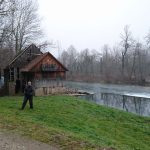The latest on the migrant crisis in Croatia, with border tensions rising.
The refugee crisis in Croatia is again in full swing. A large number of refugees in Serbia is waiting to enter Croatia, while Slovenia does not want to accept all the refugees that are arriving from Croatia. Around 700 refugees have spent the night at Berkasovo, on the Serbian side of the border, and are currently waiting for entry into Croatia. Reportedly, in Serbia there are 10,000 more refugees who are coming to the Croatian border, reports Index.hr, Jutarnji List and Vecernji List on October 20, 2015.
The Slovenian government held an emergency session which lasted until 4 am this morning and has decided to send to Slovenian parliament amendments to the Law on Defence which would give the Slovenian army additional powers. On the basis of these amendments, the military would be able to help the police in monitoring and guarding the border. Slovenian parliament could adopt the amendments as early as today. In a statement after the meeting which lasted for six and a half hours, the Slovenian government said that the inflow of refugees has exceeded the numbers for which Slovenia was prepared. They claim that on Monday 8,000 people entered Slovenia, while just 2,000 refugees left for Austria, although Austria claims that it has not changed its policy towards migrants.
“The migrant pressure from Croatia is increasing. Croatia has decided not to report the arrival of migrants and sometimes even intentionally scatters them near the border. Because of this behaviour of neighbouring countries, 6,000 people have stayed in Slovenia, mostly women and children”, said the Slovenian government. “Slovenia calls on states and European institutions to take over some of this disproportionate burden for our country”, said the Slovenian government. They stressed that it was impossible to expect that the country with just two million inhabitants could solve the problem which many larger states have not solved.
Due to the problems at the Slovenian-Croatian border, Croatia has intermittently closed for refugees its border with Serbia. Serbian minister of labour and social affairs Aleksandar Vulin visited early Tuesday a reception centre in Principovac and the Berkasovo border crossing with Croatia where on Monday several thousand migrants crossed the Croatian border, which was however closed again on Tuesday morning. “The Croatian authorities have again closed the crossing at Berkasovo, but we expect that the crossing will be opened later in the morning”, said Vulin, adding that the conditions for the people there should be improved. He added that in Preševo camp in southern Serbia there are about 300 people, but he expected that the number would increase to some 5,000.
At the Berkasovo border crossing, currently there are some 700 people waiting to cross into Croatia. “Serbia will not force anyone to stay here and will not turn itself into a concentration camp. It is up to these people to decide where they will go”, concluded Vulin.
From midnight to 9 pm on Monday, 3,397 migrants entered Croatia. Currently, at the Opatovac temporary reception centre there are 2,348 migrants. Since the beginning of the migration crisis, a total of 200,577 migrants have entered Croatia.
According to UNHCR, there were as many as 10,000 refugees moving through Serbia yesterday. After Slovenia partially blocked its border early on Monday, Croatian police restricted the number of people coming from Serbia, which resulted in growing tensions on the border between Serbia and Croatia.
“This will continue until the problem is resolved in Greece and Turkey. The only way to stop people is to construct a physical barrier, wall or fence. That is something that Slovenia, Austria, Germany and Croatia have so far not decided to do”, said Croatian prime minister Zoran Milanović.
However, according to Jutarnji List, Croatian government is prepared to start construction of a fence on the border with Serbia. Plans for the fencing of the border exist for some time, and estimates suggest that the construction would last for about two weeks. “If Slovenia or Austria drastically reduce the number of migrants they are willing to accept, we will have to restrict the number of people coming from Serbia. In that case, the construction of the fence would last for several weeks”, said for Jutarnji List a source from the Croatian government.
In that case, the most likely option is for the refugee wave to be redirected to Romania and Hungary, which has not constructed a fence on that part of its border. From there, the migrants continue toward Austria and further to their destinations. The second option is for migrants to cross from Serbia into Bosnia and Herzegovina, but that is considered unlikely, because the migrants would have to pass natural obstacles, such as the Drina River and the high mountains. However, if that were to happen, Croatia would found itself in trouble because it would be extremely difficult to effectively monitor a thousand kilometre long border line with Bosnia and Herzegovina.
However, the prime minister said yesterday that the fence between Croatia and Serbia to stop the refugees was “absolutely the last solution” and that it would be ugly and wrong to do that. Milanović pointed out that at the meeting of the European Council, in front of 29 European leaders, he asked whether Europe wants Croatia to build the wall. “I looked in the direction of Sweden, Germany and Austria, and they said no”, Milanović added.









